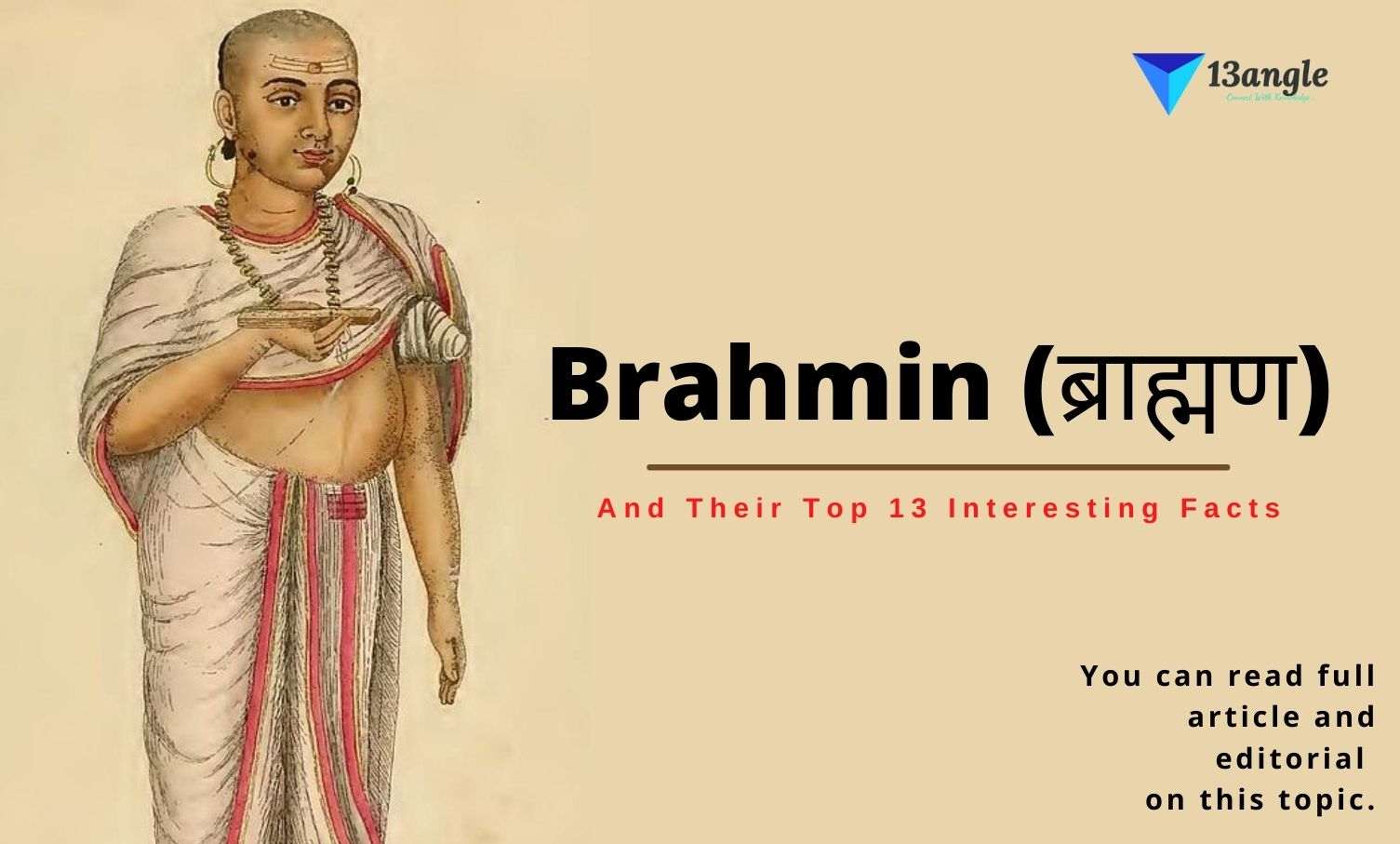- Umang Sagar
- Recent article, Religion
Brahmin (ब्राह्मण)
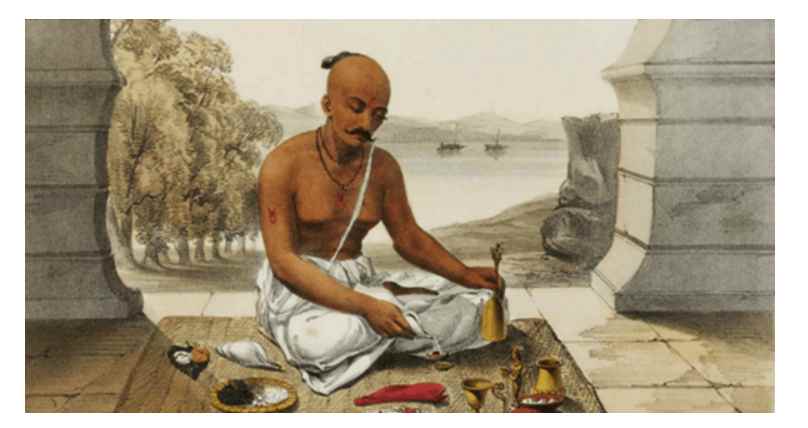
विधाता शासिता वक्ता मैत्रो ब्राह्मण उच्यते।
तस्मै नाकुशलं ब्रूयान्न शुष्कां गिरमीरयेत्॥
(‘शास्त्रो का रचयिता तथा सत्कर्मों का अनुष्ठान करनेवाला,
शिष्यादि की ताडनकर्ता, वेदादि का वक्ता और सर्व
प्राणियों का हितकामना करनेवाला ब्राह्मण कहलाता है।’)[मनुस्मृति 11.35]
Brahmin (Sanskrit: ब्राह्मण)
- The fundamental reality of the cosmos is Brahmin. It is the ultimate cause of all that exists. It is the all-encompassing, limitless, eternal truth, consciousness, and happiness that does not change but is the source of all changes. The word Brahmin translates to “Supreme Self” or the first of the gods. In Hinduism, Brahmins are classified as Varnas (classes). They are scholars, teachers (gurus, acharyas), and priests (pandit, purohit, pujari). They are ayurvedic experts who treat individuals with natural remedies. The Brahmins are the most esteemed of the four social castes. Brahmin is a Vedic Sanskrit word that is also known as Brahman. The core of the Vedas is Brahman, which is extensively explored in the early Upanishads. Brahmins are considered to be Vishnu’s avatars, and they are revered by all.
Origin Of Brahmin
1. In Vedas
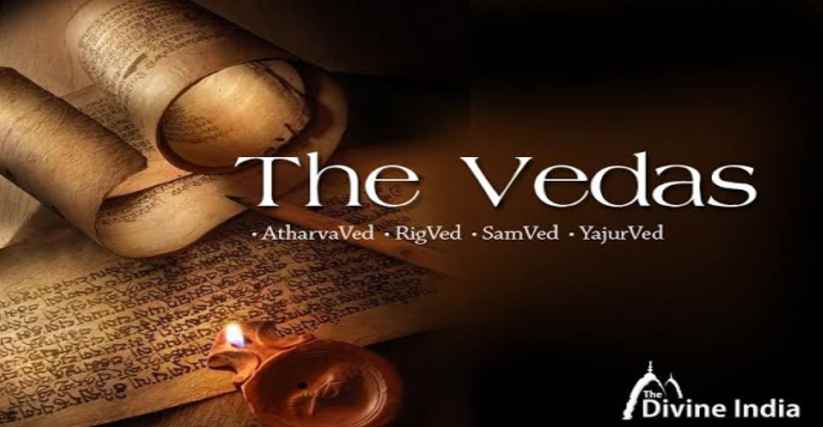
- Purusha Sukta is the earliest holy scripture in which the term Brahmin is defined. Purusha Sukta is a well-known Rigvedic hymn 10.90, from one of the most revered Hindu scriptures, the Rigveda. The god Prajapati (Lord of Beings) is linked to Brahma, the Hindu trinity’s creator who was eventually sacrificed by his children.
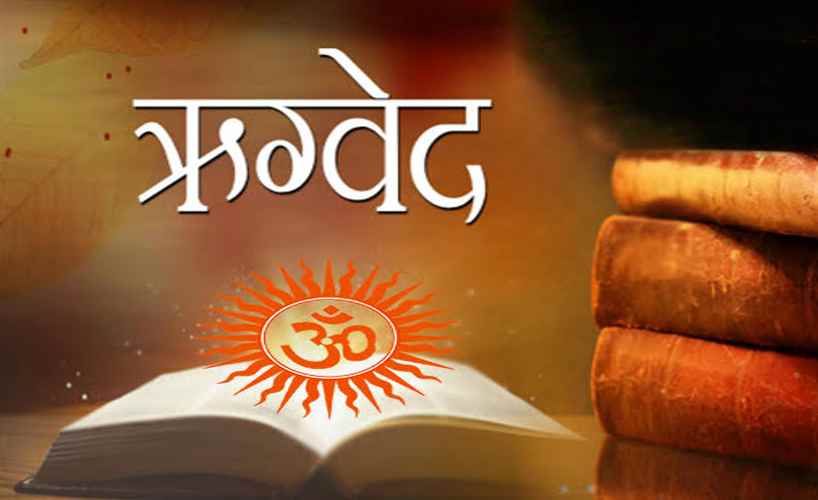
The universe is claimed to have been created as a result of this sacrifice, and the Brahmin is thought to have come from his mouth. It’s also found in hymns from the Atharva Veda, such as 6.122.5, 10.1.12, and 14.1.131.
According to Jon Gonda, the various references to Brahman in Vedic literature, beginning with the Rigveda Samhitas, transmit “multiple senses or different shades of meaning.”
2. In Upanishad
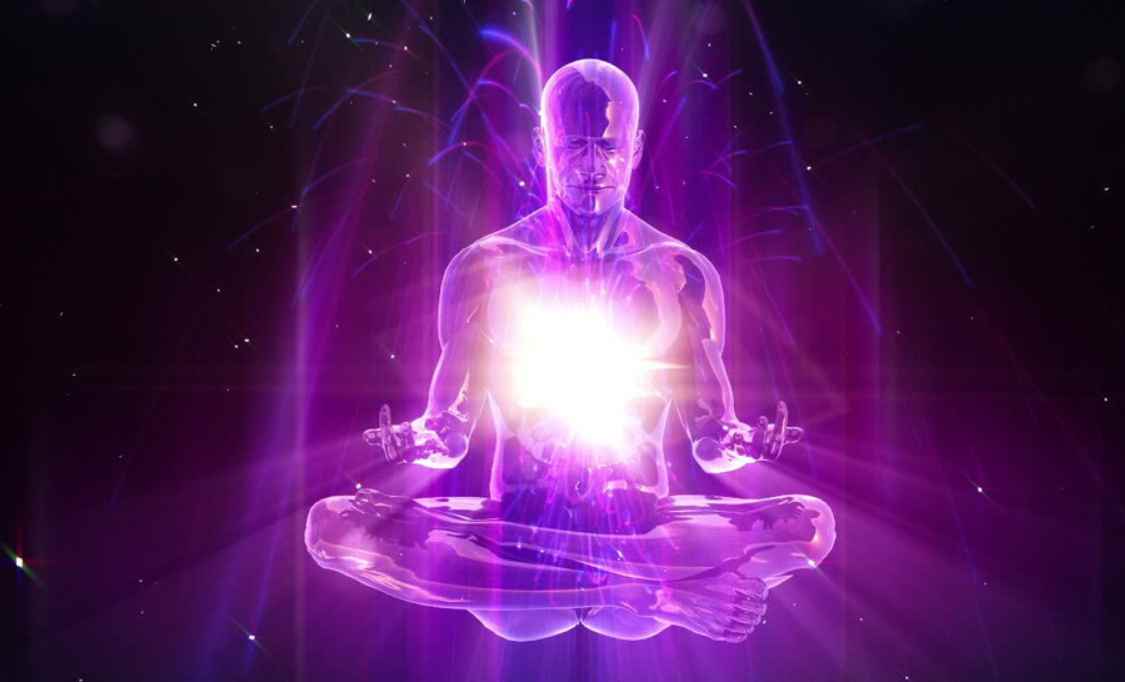
The Upanishad describes Brahmavidya and Atmavidya, or the knowledge of Brahman and Atman (self), as well as what they are and how they work. The Upanishad text analyses the text or phrase that blossomed in the post-Vedic era, rather than defining it.
According to Gavin Flood, the Upanishads define Brahman as the “essence, the smallest particle of the cosmos, and the limitless universe.”
3. In Hindu Mythology

According to Mahabharata, Sudra who is firm in spiritual disciplines like integrity, forbearance, justice, and others can attain Brahminhood.
It further says all of God’s creatures are equal, and caste classification is based on personal preferences.
Sri Krishna, who is revered by all Hindus, including Brahmins, was born from the Yadava caste, a modern-day backward community.
Santanu, the king, and his brother Devapi, the scholar, are two examples of one offspring of the same mother being crowned as a king and another being anointed as a priestly Brahmana in mythologies.
Brahma, Brahmin And Brahman
Brahma- In post-Vedic Puranic literature, Brahma is a male deity whose sole function is to create. In the Trimurti, he is referred to as a creator (Brahma, Vishnu, Mahesh)
Brahmin- Brahmin is a Varna in Hinduism. According to Rigveda Brahmin is originated from the mouth of Brahma
Brahman- Brahman is a caste in Hinduism Varna Brahma. Brahman is a Hindu philosophical term that refers to the ultimate, unchanging reality. Brahman is eternal, infinite, transcendent, the cause, the foundation, the source, and the goal of all existence.
The Concept Of Brahman
- Brahman is a tough idea to grasp since it has so many layers of significance.
=> Brahman in various concepts:
1. Metaphysical Concept
- Although it is well recognized that Brahman is the ultimate reality, it is equally true that the universe is always temporarily changing. Thus, the metaphysical idea of Brahman is founded on two questions: what is the ultimate reality, and are there universal rules that apply to all reality? As a result, it is clearly split into two parts: Atma (the ultimate reality) and Maya (the perceived reality).
Maya is perceived reality, one that does not reveal hidden principles, while Atman is the ultimate reality, which is Brahman, according to Hinduism’s metaphysics. Maya is asleep, but Atman-Brahman is awake; Maya is the literal and effect, whereas Brahman is the symbolic Updna (the principle and the cause). Maya changes with time, as it is born, changes, evolves and dies as a result of unseen forces, but Atman-Brahman is everlasting, unchangeable, unaffected, invisible, and resplendent consciousness.
2. Ontological Concept
- The ontological principles of Indian philosophy are Brahman and Self (Atman).
- There are a few variations on this concept: Buddhism denies the existence of the self (Atman), whereas Jainism affirms the reality of the self (Atman).
- According to the Ontological idea
“God is in himself”
- Knowing one’s own self is the same as knowing the God within oneself, and thus is regarded as the road to understanding the ontological nature of Brahman (universal Self) because it is similar to the Atman (individual Self).
3. Axiological Concept
- The axiological concept is a Hindu theory of values: ethics and aesthetics.
अहं ब्रह्म अस्मि
(I am Brahman)
[Brihadaranyaka Upanishad 1.4.10]
According to Shaw, a statement like the above means “I am related to everything,” and this is the primary reason for compassion in Hinduism, because each individual’s welfare, tranquility, or happiness is dependent on others, including other beings and nature in general, and vice versa.
Titege states that the theory of values emphasizes individual agents and ethics.
According to Nikam, the axiological underpinnings of Hindu thinking and Indian philosophies, in general, are to elevate the individual by exalting man’s natural potential, where his existence is the objective reality of the universe.
4. Teleological Concept
- Teleology is the study of something’s apparent aim, principle, or objective. These issues are addressed in Shvetashvatara Upanishad’s first chapter. Scholars’ translations have varied slightly, with Max Muller rendering the questions as follows:
The Brahma students say: Is Brahman the cause? When are we born?
Whereby do we live, and whither do we go?
O ye who know Brahman, tell us at whose command we abide, whether in pain or in pleasure.
Should time, or nature, or necessity, or chance,
Or the elements are considered as the cause, or is he who is called the Purusha?
It cannot be their union either, because that is not self-dependent and the self also is powerless, because there is, independent of him, a cause of good and evil.
— Shvetashvatara Upanishad 1.1-1.2, Translated by Max Muller
- The question proposed by Shvetashvatara Upanishad’s first chapter is answered by the Aitareya Upanishad 3.3 and Brihadaranyaka Upanishad 4.4.17 and many other Upanishads.
Everything is various names only of Knowledge (the true Self)
Everything is led (produced) by knowledge.
It rests on Knowledge. The world is led by Knowledge. Knowledge is its cause.
Knowledge is Brahman.
— Aitareya Upanishad, Chapter 3
According to Upanishad, the key to the Universe’s puzzle is one’s own inner self. To understand the universe, one must first understand oneself. The Aitareya Upanishad advises that you become everlasting by being yourself.
As a result, the Brahman is a teleological term since it is the ultimate end and purpose of all that is conceivable, and it pervades and is in everything.
5. Soteriological Concept
This is a concept of Moksha.
Moksh means an absence of suffering and release from bondage to saṃsāra (birth-rebirth cycle).
The notion is also explained in Hinduism as the presence of the state of Paripurna-Brahmanubhava (oneness with Brahman, the One Supreme Self), which is a state of knowledge, calm, and happiness.
One of several meditative steps on the way to moksha is explained in an ancient literature on moksha as follows:
जाति नीति कुल गोत्र दूरगं
नाम रूप गुण दोष वर्जितम्।
देश काल विषया तिवर्ति यद्
ब्रह्म तत्त्वमसि भाव यात्मनि॥
(Beyond caste, creed, family, or lineage,
That which is without name and form, beyond merit and demerit,
That which is beyond space, time, and sense-objects,
You are that God himself; Meditate this within yourself)
— Vivekachudamani, 8th Century CE
Brahman In Buddhism, Sikhism And Jainism
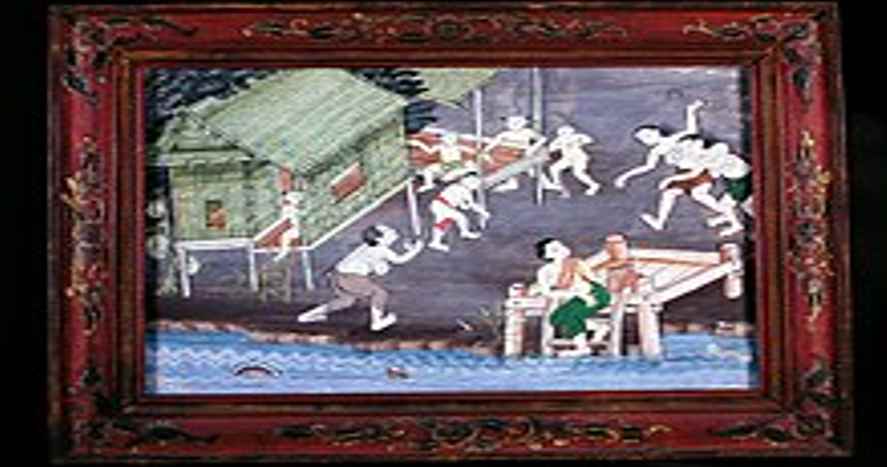
The term Brahmin appears frequently in Buddhist and Jain Sutras and commentary literature from antiquity and medieval times. Buddhism rejects the Upanishad scripture, which asserts the existence of Brahman and Atman.
“The Buddha declared he could uncover no evidence for the existence of either the personal Self (atman) or its cosmic counterpart (Brahman),” writes Damien Known.
In the Yogacara school of Mahayana Buddhism, “the Body of Essence, the Ultimate Buddha, who penetrated and underlay the entire cosmos was in fact the World Self, the Brahman of the Upanishads, in a new form,” according to William Theodore De Bary.
Sikhism is built on the metaphysical concept of Brahman, notably as nirguni Brahman—attributeless, formless, eternal Highest Reality. The Sikhs observe this belief through nirguni Bhakti.
Sikhism’s thoughts on God and the Highest Reality are similar to Hinduism’s Saguna and Nirguna Brahman concepts.
Such as:
एकमेवाद्वितीयम्
(“That [Brahman] is one, without a second”)
[Chandogya Upanishad 6.2.1]
Similar emphasis for the metaphysical concept of Brahman is also written in Gauri, which is part of Guru Granth Sahib.
According to Nesbitt, scholars have translated the first two words, Ik Onkar, in the twelve-word Mul Mantar at the beginning of the Sikh text Guru Granth Sahib in three different ways: “There is one god”, “This being is one”, and as “One reality is”. In Sikhism, the notion of Brahman is known as Nam, Sat-Naam, or Naam.
It is unclear if Jainism accepts or rejects the concept of Brahman.
According to Bissett, Jainism recognizes the “material universe” and “Atman,” but not Brahman, the metaphysical idea of Ultimate Reality and Cosmic Principles contained in Hinduism’s ancient teachings.
According to Jaini, Jainism neither accepts nor rejects the premise of Ultimate Reality (Brahman), but instead adopts a multi-faceted view known as Anekantavada. According to this theory, “reality is irreducibly complicated,” and “no human vision or description can accurately capture the Absolute Truth.” The emancipated and the Supreme Self (Paramatman) with Kevala Jnana are those who have grasped and realized the Absolute Truth.
Symbol Of Brahman
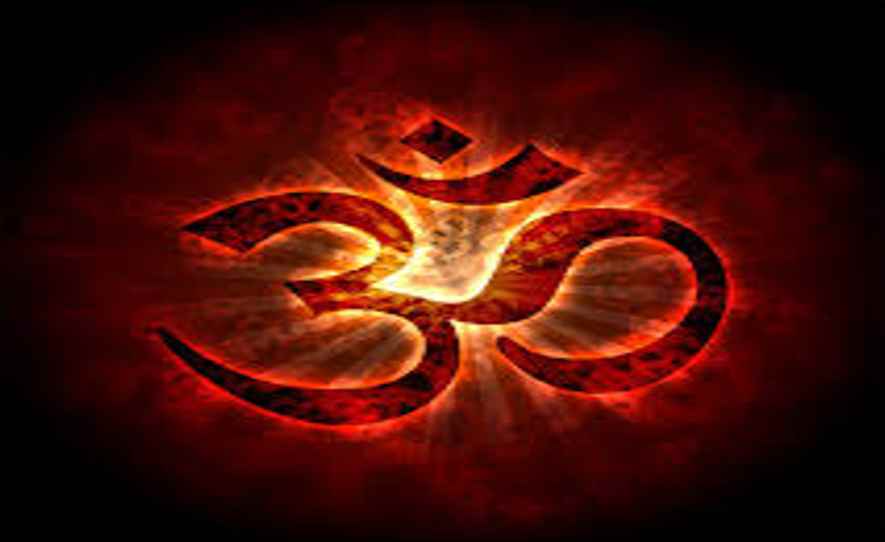
- Brahman is a God or the Supreme Being for Hindus. Although Brahmans are beyond human comprehension, Hindu scriptures attempt to describe Brahman. However, Nirgun and Sagun are the most common descriptions of Brahmans.
1. Nirgun Brahman
The notion of Nirguna Brahman is that God has no shape or form. Because Brahman is difficult for humans to comprehend, Hindus utilize various symbols to depict it, such as the aum or om symbol. The sound that existed when the world was created is represented by the aum or om sign.
2. Sagun Brahman
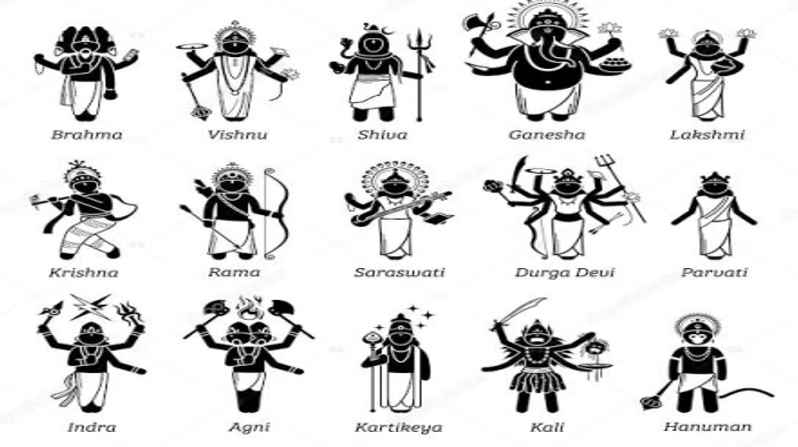
- The concept of Saguna Brahman is that Brahman has a form and can be comprehended through images. These images are divine expressions. Each picture depicts a different manifestation of Brahman, which can take the form of a human or an animal. This indicates that Hindus can comprehend Brahman through Hinduism’s tens of thousands of deities and their qualities or attributes.
Categories Of Brahmin
=> Before the formation of society;
- Smriti Puran explains the Brahman differentiation. There are eight types of Brahmins, according to the Smriti Puran:
- Mere
- Brahmin
- Srotriya
- Anuchan
- Embryo
- Rishikalp
- Rishi, and,
- Muni
- Brahmins who are exalted from descent, knowledge, and virtue are Trident, and Brahmins are also known as Dharmgya Vipra and Dwij.
1. Mere (Matra)
- Those Brahmin who is not Brahmins by karma, but by Caste only is called Matra. Without Brahmin-oriented Upanayana rites and Vedic deeds, they are called Matra. They worship a variety of deities and enjoy the pleasures of the night, earning the name Rakshash (demon).
2. Brahmin
- Brahmins are those who are close to God, Vedpathi, Brahmagami, simple, reclusive (prefers to be alone), truthful, and wise. They do not practice distinct forms of worship as described in the Purans, and they live their lives according to the Vedas.
3. Srotriya
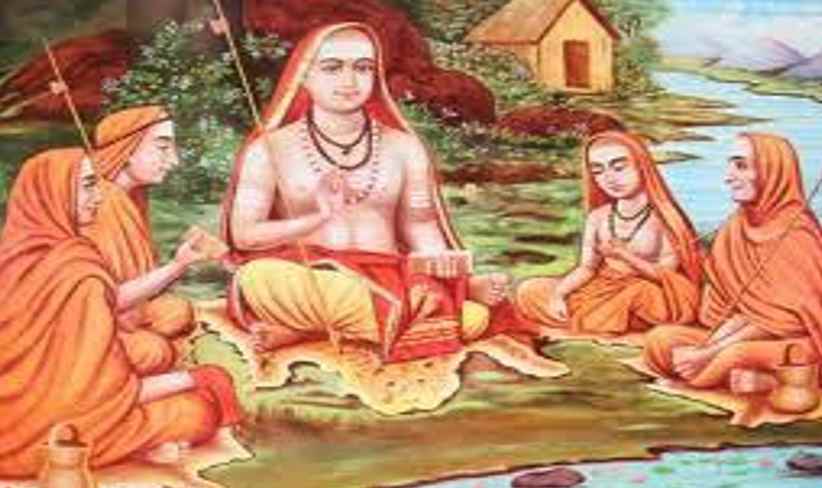
- According to the Smriti, anyone who reads any branch of the Veda with Kalpa and all six limbs is enriched in Brahmanism’s six actions, and is referred to be “Shotriya.”
4. Anuchan
- Anuchan is a person who has attained enlightenment through the Vedas and Vedangas, is sinless, has a pure mind, is superior, teaches, and educates Vedic students.
6. Embryo (Bhrun)
An embryo is a person with self-control who possesses all of the traits of an Anuchan but exclusively engages in Yajna and Swadhyaya.
7. Rishikalp
- Rishikalp lives in an ashram while remaining celibate and is a person who knows all Vedas, Smritis, and cosmic themes subdue the mind and senses.
8. Rishi (Sage)
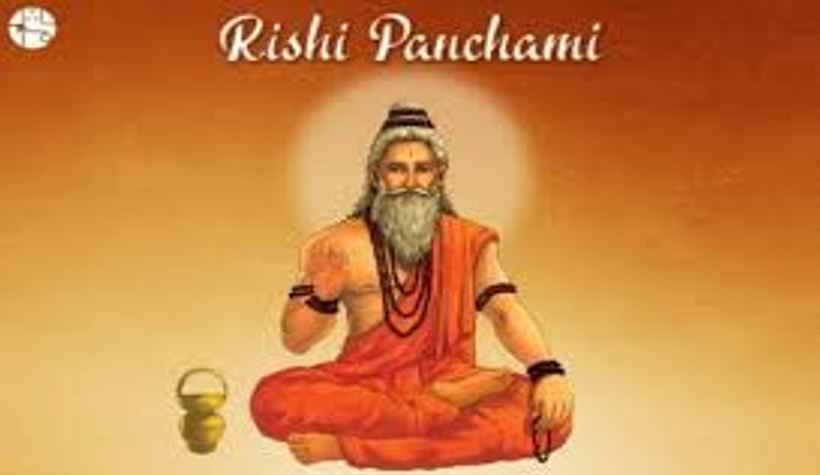
- A Rishi is a truthful and capable person who is above all doubts, who remains brahmachari (celibate) while following a proper diet, dietary habits, and so on, and whose curse and grace are coming to fruition (sage).
9. Muni
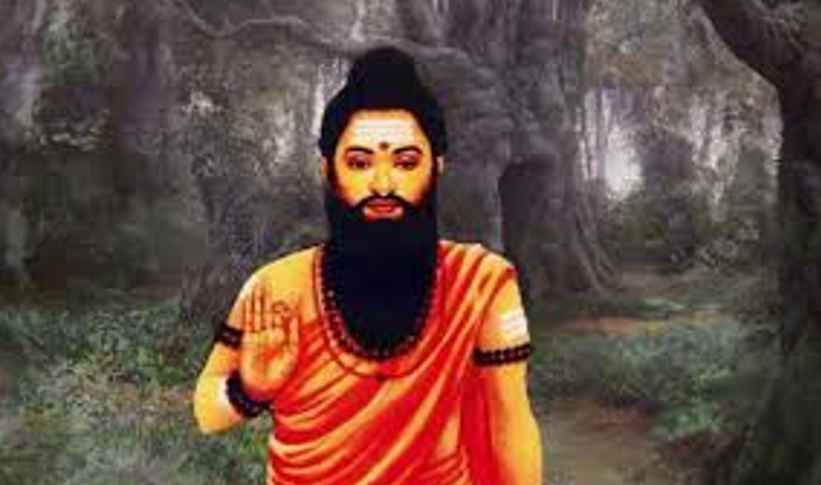
- A Brahmin who follows the path of isolation and has knowledge of all elements, meditation, Jitendriya (control over his five senses), and Siddh is known as a Muni. The Brahmin did not belong to any caste or society then.
=> After the formation of society;
- Saryuparin, Kanyakubj, Jijhotia, Maithil, Marathi, Bengali, Bhargava, Kashmiri, Sanadhya, Gaur, Maha-Baman, and other Brahmins have the highest division or classification in India. Brahmins are also known for having the highest surname (surname or title). The origins of these surnames can be traced back to the Middle Ages, such as,
Pathak was a Brahman who recited one Veda.
The two Veda reciters were given the names Dwivedi and Dubey throughout time.
Trivedi, also known as Tripathi, eventually became Tiwari, was the name given to the person who read the three Vedas.
Chaturvedi, who eventually became Chaubey, is the name given to the four Vedas chanted.
Shukla Yajurveda readers are referred to as Shukla or Shukla.
A Pandit was a person who knew the four Vedas, Puranas, and Upanishads and was afterward known as Pandey, Pandey, Pandiya, and Padhyaya. Padhyaya was eventually renamed Upadhyaya.
The title of Shastri was bestowed on those who held Shastras or performed Shastras.
Aside from these, descendants of notable sages used their Rishikul or gotra name as a surname, such as- Bhagavan Parasuram also belonged to the Bhrigu clan. The descendants of the Bhrigu clan are called Bhargav, similarly Gautam, Agnihotri, Garg, Bhardwaj, etc.
Many monarchs bestowed titles on many Brahmins, which were later adopted as surnames by their successors. Brahmin surnames became fashionable as a result of this. Rao, Rawal, Maharawal, Kanungo, Mandalik, Zamindar, Chaudhary, Patwari, Deshmukh, Cheetnis, Pradhan, and others are some examples.
There are thousands of surnames in the Banerjee, Mukherjee, Joshiji, Sharmaji, Bhattji, Vishwakarmaji, Maithliji, Jha, Dhar, Srinivas, Mishra, Mendola, Apte, and other families.
=> Sakaldwipiya Brahmins
Sakaldwipiya Brahmins are the well-known Brahmins in history and the only class of Brahmin which is mentioned in Vedas and Puranas.
They are also known as Bhojaka Brahmins or Maga Brahmins.
They are a class of Brahmin priests, Ayurveda teachers, and practitioners (Vaidya) that are concentrated in northern India. These Brahmins are mentioned in Samba Purana and the legend made its way to Bhavisya Purana in 12th-century inscription in Eastern India.
In modern times, the Sakaldwipiya Brahmins of Bihar, Odisha, Bengal, and Uttar Pradesh are Ayurvedic physicians, priests, and landholders.
The Brahman Dynasty
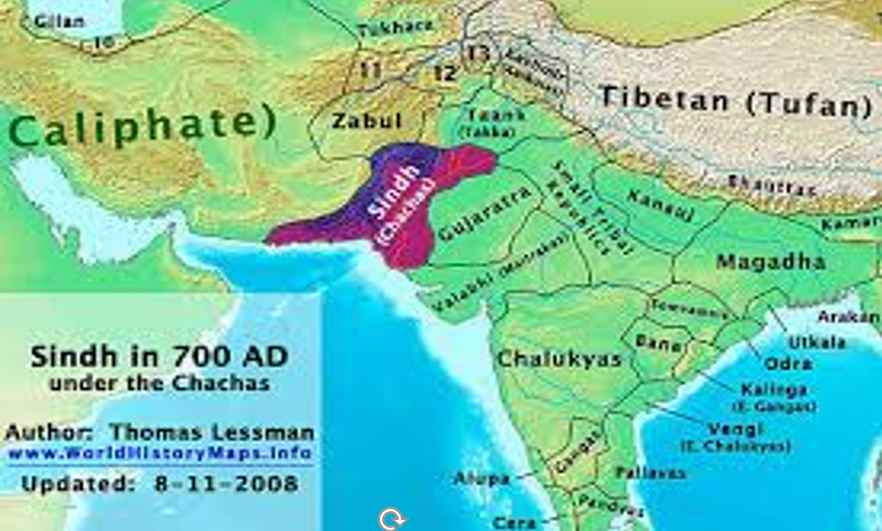
- Since the Late Vedic period the Brahmins, who were generally classified as priests, mentors, teachers who were also Rulers, Zamindars, Kings, Warriors, and holders of other highest administrative posts. Due to their martial abilities, Brahmans were described as ‘the oldest martial community’, in the past having two of the oldest regiments, the 1st Brahmans and 3rd Brahmans.
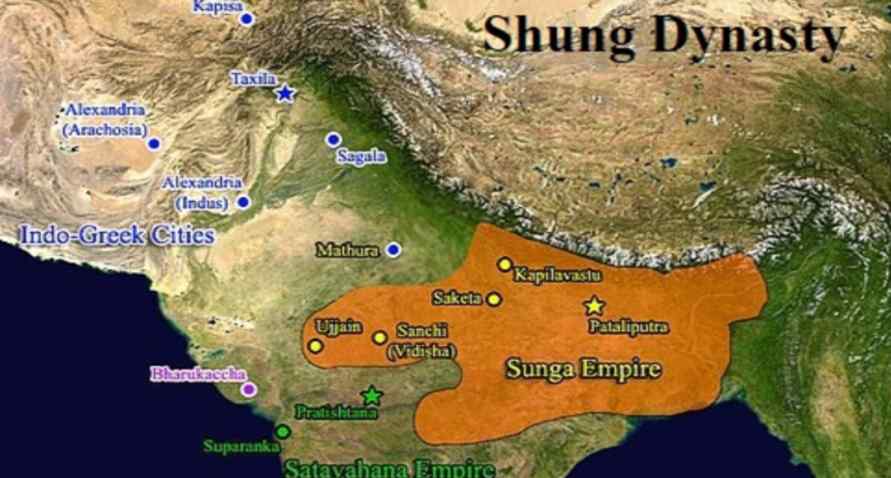
There is a list of Brahmin empires, dynasties, ruled by Brahmins in the Indian subcontinent:
Pushyamitra Shunga established the Shunga Empire of Magadha.
The Kanva Dynasty replaced the Shunga Empire in Magadha and Ruled in the Eastern regions of India.
The Satavahana Dynasty ( 230bc to 250ad) In the present-day part of Madhya Pradesh, Gujrat, Maharashtra, Telangana, Rajasthan, Northern Karnataka, etc.
Parivrajaka Dynasty Ruled parts of Central India during the 5th and 6th centuries. The kings of this Dynasty bore the title Maharaja and probably Ruled as feudatories of the Gupta Empire. The Royal Family came from a Lineage of Brahmins of Bharadwaj Gotra.
Kadamba Dynasty (345 – 525 CE) was a Dynasty that Ruled Northern Karnataka and the Konkan from Banavasi in the present-day Uttara Kannada district.
Pallava Dynasty {c.285 -905 CE} was a Tamil brahmin of Bharadwaj gotra (Tamil Samaṇar Dynasty ), Pallavas Ruled Andhra (Krishna-Guntur), and North and Central Tamil Nadu. Appar is traditionally credited with converting the Pallava king, Mahendravarman to Saivism.
The Oiniwar Dynasty, based in Mithila were Maithil Brahmins.
Vakataka Dynasty was a Dynasty from the Indian subcontinent that is believed to have extended from the southern edges of Malwa and Gujarat in the North to the Tungabhadra River in the South as well from the Arabian Sea in the West to the edges of Chhattisgarh in the East.
Brahman Dynasty of Sindh was founded By Chach of Alor, later Ruled By Chandar of Sindh and Raja Dahir.
Bhurshut Dynasty was a medieval Hindu Dynasty spread across what is now Howrah and Hooghly districts in the Indian state of West Bengal; which was Ruled By a Royal Brahmin Family.
Baghochia Dynasty was founded By Raja Bir Sen and was the ruling Dynasty of Hathwa Raj and Bans Gaon State. The Cadet branch of the Family also Ruled Tamkuhi Raj, Salemgarh Estate, Ledo Gadi, Kiajori estate, and Kharna Ghatwali.Bhumihar dynasty.
Kabul Shahi Dynasty belonged to the Bali clan of Mohyal Brahmin.
Aryacakravarti Dynasty was Ruled By Tamil Brahmins.
Peshwai, Peshwas were Brahmin and were the De facto rulers of the Maratha Empire.
Patwardhan Dynasty was an Indian Dynasty established By the Chitpavan Brahmin Patwardhan Family.
Brahmin Regiments
The Brahmans only enlist in two-class regiments of the Indian Army. Their breeding and pride of race are evident in their cleanliness and smartness on parade. They are excellent athletes, great wrestlers, and excel in strength feats; they also have a strong reputation for bravery. Regrettably, they have seen little service since the introduction of the class system and hence have not had the opportunity to add to their remarkable record.
1. Brahmin 1st Regiment (1st Brahmans)
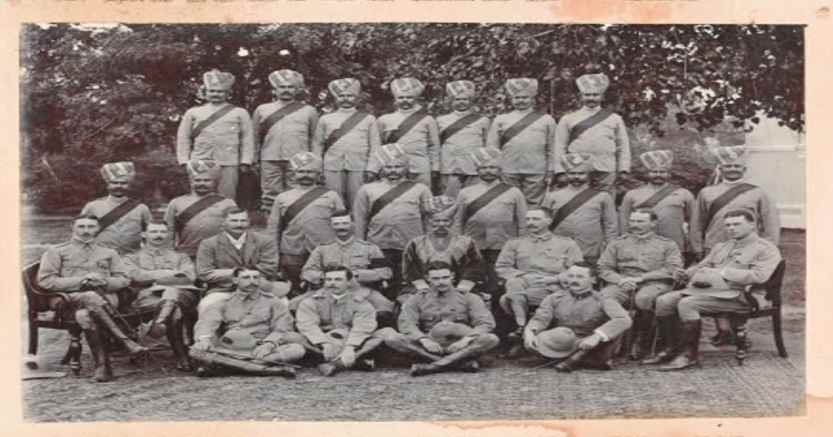
The 1st Brahmans were a British Indian Army infantry regiment. Captain T Naylor raised it in Oudh in 1776 for service in the army of Nawab Wazir of Oudh, and it was known as the Nawab Wazir’s Regiment. In 1777, it was renamed 30th Battalion, Bengal Native Infantry, and transferred to the East India Company. At the same time, due to changes in time, it was renamed the 1st Brahmin Infantry for the first time in 1901.
Its name was changed to 1st Brahmans after only two years. The 1st Brahmans were one of India’s professional armies, famed for their gorgeous uniforms.
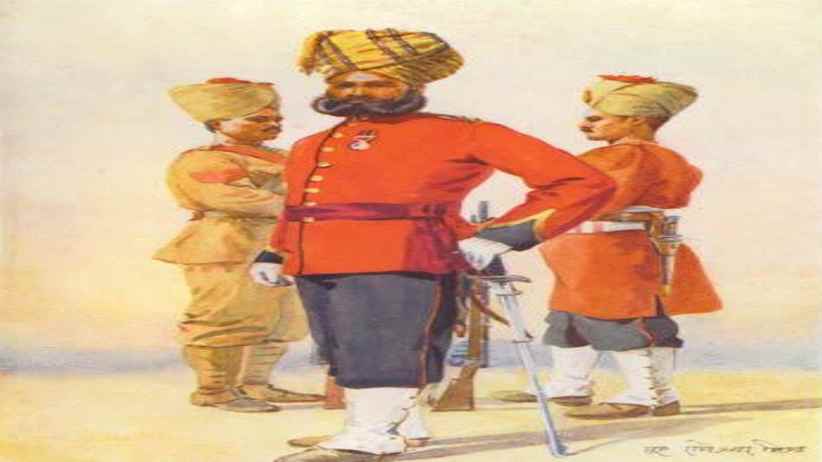
- It was afterward renamed the ‘4th Battalion 1st Punjab Regiment’ in 1922. However, due to a variety of factors, this infantry unit was disbanded in 1931.
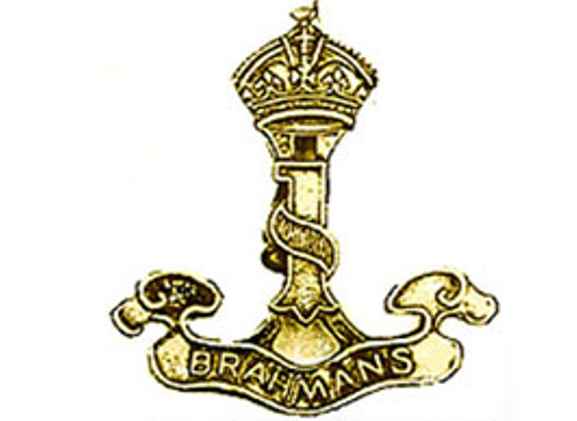
Because the Brahmin regiment was recognized for its fighting abilities, various tags could be found on its gorgeous outfit.
Their skills were waived in the Second Maratha War 1803-05, the Anglo-Nepalese War 1814-16, the Second Anglo-Burmese War 1824-26, and the Bhurtpore Campaign 1826.
2. 3rd Brahmin Regiment (3rd Brahmans)
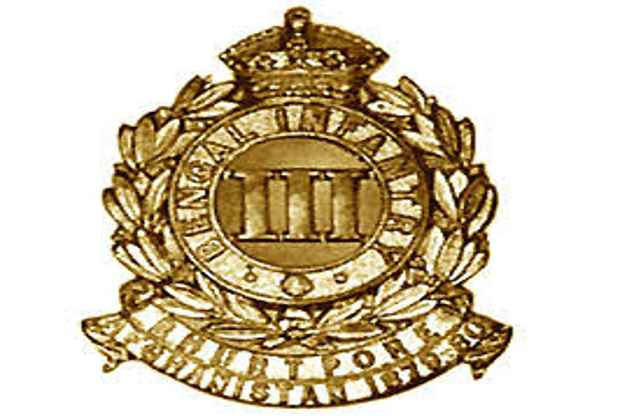
The 3rd Brahmans were also a British Indian Army Infantry Regiment. Its origins could be traced to 1798.
When they were the 1st battalion, they were called. 16th Bengal Native Infantry. They went under a number of different names over the years. The 32nd Bengal Native Infantry served from 1824 to 1861, the 3rd Bengal Native Infantry served from 1861 to 1885, the 3rd Bengal Infantry served from 1885 to 1900, and the 3rd Brahmans served after the Kitchener reforms (by Lord Kitchener) of the Indian Army when the names of the presidencies were dropped.
After serving in the Second Anglo-Afghan War and the Second World War, it was decommissioned in 1922.
Role Of Brahmin
- The role of the Brahmin has evolved over time.
1. Ancient Times
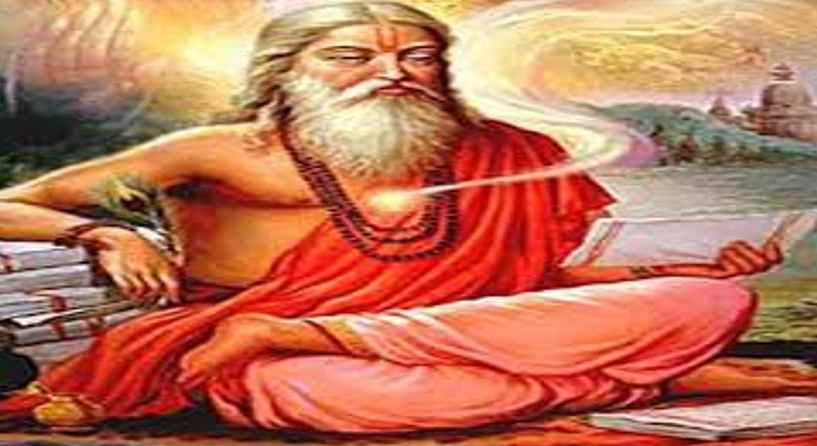
The concept of Brahmin emerged in ancient India. Early Brahmins’ cultural and religious customs demonstrate that they are essentially a ceremonial group that practices a range of primordial faiths. On the basis of their Yajna philosophy, they devised several religious rituals. It was originally linked to animal sacrifices and a variety of other rites. Through the concept of dan-Dakshina, it had become a source of income for them (donation). As Brahmins began to prescribe rituals for every social and individual event, from birth to death, rituals were increasingly associated with more and more areas of social and cultural life, and this growth elevated the Brahmin group to Priesthood, which was also divine.
Brahmin claimed that they mediator between God and humans. Such beliefs led to the concept that God could only be satisfied by Brahmins. Even kings became Brahmins’ servants.
Brahmans of this time follow the Vedas wholeheartedly.
2. Madievel Times
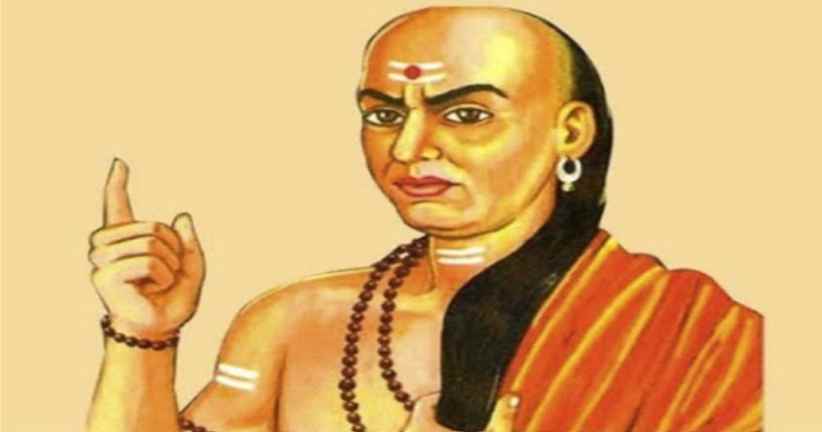
According to historical records and academic statements, Brahmin Varna was not restricted to any particular status, such as priest or teacher. There are numerous examples from history that show that Brahmins were disseminated throughout the country. Chanakya is a brahmin whose fame has endured to this day. He was a polymath who served as a teacher, author, strategist, philosopher, economist, judge, and royal counselor in ancient India. He aided Chandragupta Maurya, the first Mauryan emperor, in his ascent to power, and is commonly acknowledged for being a key figure in the founding of the Maurya Empire.
Brahmins were agriculturalists and warriors in medieval India, according to historical sources dating from the mid-1st millennium CE and beyond.
According to Donkin and other academics, Brahmin merchants “carried on commerce in horses, elephants, and jewels” and moved products throughout medieval India before the 14th century, according to Hoysala Empire documents. Brahmins’ livelihoods were recorded in Buddhist writings such as the Jataka Tales to include farming, handicraft workers, and artisans such as carpentry and building. Telugu Niyogi Brahmins performed in a variety of roles under the Golconda Sultanate, including accountants, ministers, revenue administration, and judicial service. During the Maratha Empire’s reign in the 17th and 18th centuries, Marathi Brahmins worked in a variety of capacities, including administration, warfare, and de facto rule.
3. Modern Times
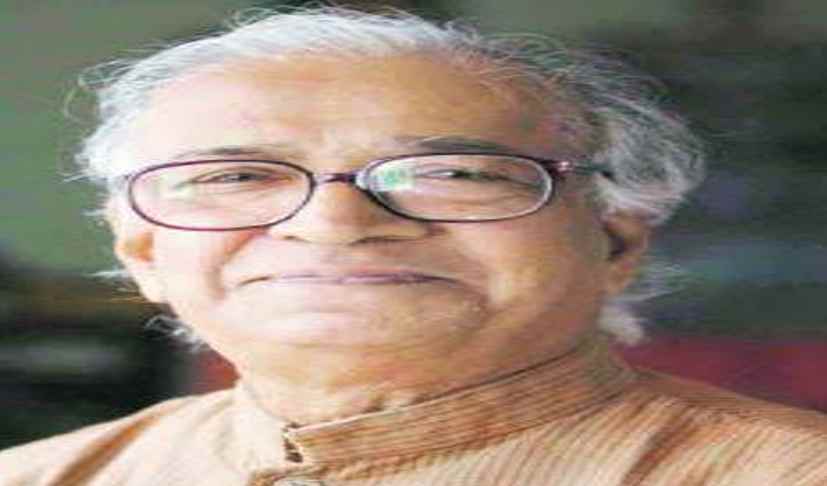
In the nineteenth century, Brahmins in Maharashtra were the first community to adopt western education and hence controlled lower levels of British administration. Similarly, during British colonial control, the Tamil Brahmins were quick to pick up English education and dominated government service and law
According to researchers, Brahmins worked in practically every sector up until the turn of the twentieth century, including temple priests, ministers, merchants, farmers, potters, masons, carpenters, coppersmiths, stone craftsmen, barbers, and gardeners, among others.
According to a survey conducted in the twentieth century, Brahmin families who work in agriculture as their primary vocation plow their own land, with many supplementing their income by selling their labor services to other farmers. The principal activity of practically all Brahmin families examined in Uttar Pradesh throughout the twentieth century was neither priestly nor Vedas-related, but rather, like other varnas, ranging from agricultural cultivation (80% of Brahmins), dairy, service, labor such as cooking, and other occupations.
Rituals Of Brahmins
- The culture of Hinduism is based on rituals. Our sages invented sacraments to make human life holy and dignified. These rites have special importance in our life not only from a religious point of view but also from a scientific point of view. These rites have a great contribution to the greatness of Indian culture. There are 16 rituals performed in Brahmin from birth till death.
1. Garbhadhan
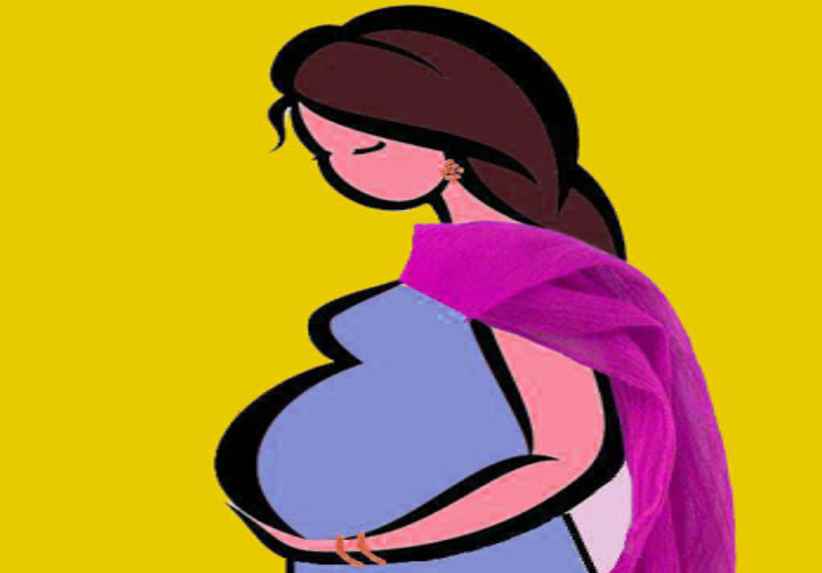
The Brahmin community has composed 16 sanskar (sacrament) the first of which is Garbhadhan.
It is a rite like this that bestows upon us a deserving, noble, and ideal child. Garbhaadhan, according to the scriptures, is conducted for the purpose of obtaining offspring of one’s own choosing. This type of ritual promotes family growth and race.
According to the Hindu faith, after a lady conceives a child in her womb, both sides of the would-be parents throw a religious celebration in the house three months later. The expectant mother was offered prayers during the ceremonial rite, which was followed by a little puja at her home.
The house’s senior women shower her with new clothes and Jewellery. Everyone prays for her well-being and good health, and appropriate desserts and sweetmeats are served. During this time, the pregnant woman begins her worship by meditating and singing Lord Shiva and Mother Parvati continuously.
2. Punsavana Sanskar
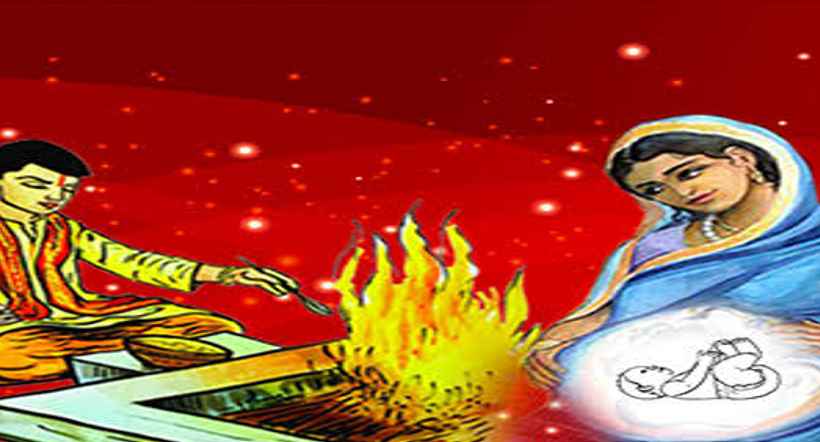
This sanskar is done to aid the foetus’ intellectual and mental development. The main benefit of this ritual is that it results in the birth of a healthy and attractive child.
After the completion of three months of pregnancy, Punsavana Sanskar should be done. Do not be too flawed by delay, but the benefit of performing this ritual on time is considered very auspicious. From the third month, both shape and behavioral ethics (sanskar) begin to catch up in the womb. Indeed, spiritual remedies should be done only on time.
All the family members from the woman’s side are given flower, rice etc from Brahmin, followed by chanting mantra and shlokas to offer to the pregnant woman. She then touches those sacred ingredients with the stomach and places it at the worship place.
Punsavana Sanskar should be performed after three months of pregnancy has passed. Do not be put off by the delay; rather, conducting this ceremony on time is said to be exceedingly fortunate. Both shape and behavioral ethics (sanskar) begin to catch up in the womb around the third month. Spiritual cures should be carried out only when the timing is right.
All female family members are given flowers, rice, and other items by Brahmins, who then sing mantras and shlokas to offer to the expectant mother. She then places the precious materials at the worship location after touching them with her stomach.
- This modest Puja was performed for the child’s welfare and good health, and the pregnant woman accepts the prayers for the child’s overall prosperity and good fortune in the womb. She receives blessings from the elders and other family members after all of this.
ॐ सुपर्णोऽसि गरुत्माँस्त्रिवृत्ते शिरो, गायत्रं चक्षुबरृहद्रथन्तरे पक्षौ। स्तोमऽआत्मा छन्दा स्यंगानि यजूषि नाम। साम ते तनूर्वामदेव्यं, यज्ञायज्ञियं पुच्छं धिष्ण्याः शफाः। सुपर्णोऽसि गरुत्मान् दिवं गच्छ स्वःपत॥ -१२.४
3. Seementroyan
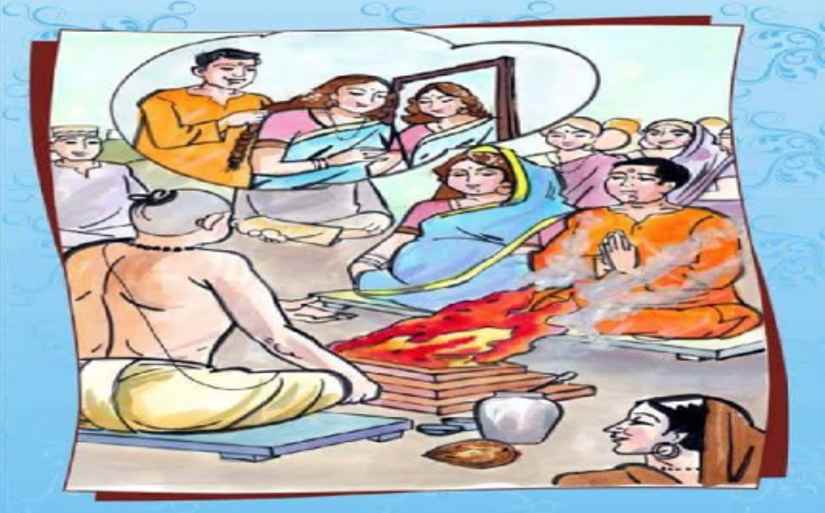
Seemantonnayan Sanskar is the third sacrament in Hindu religious rites. This sacrament is an extension of Punsavana. Its literal meaning is- “Semant” meaning ‘hair and upgrade’ meaning ‘to raise’. During the ritual ceremony, the husband used to lift the hair of his wife upwards while grooming, hence the name of this ceremony was named ‘Semantonnayan’.
For the infant in the womb, this ritual (sanskar) is conducted in the fourth, sixth, and eighth months. During this time, the physical development of the child is influenced by what the mother knows, does, and says. As a result, the mother reacts in the same way, allowing a child to learn about ethics, temperament, and action.
According to Hindu texts, the husband should divide his wife’s hair with a sycamore twig while reciting Om Bhurvinayami, Om Bhuvinayami, and Om Bhurvinayami. After that, the husband should recite the following mantra:
येनादिते: सीमानं नयाति प्रजापतिर्महते सौभगाय।
तेनाहमस्यौ सीमानं नयामि प्रजामस्यै जरदष्टिं कृणोमि।।
(अर्थात देवताओं की माता अदिति का सीमंतोन्नयन जिस प्रकार उनके पति प्रजापति ने किया था उसी प्रकार अपनी संतान के जरावस्था के पश्चात तक दीर्घजीवी होने की कामना करते हुए अपनी गर्भिणी पत्नी का सीमंतोन्नयन संस्कार करता हूं।)
- Following this, the pregnant woman should seek the blessings of an elderly Brahmin or woman in her family or neighborhood. Following the blessings, a vidhi is performed to feed the pregnant woman khichdi with ghee. The scriptures make reference to this as well.
4. Jaatakarma
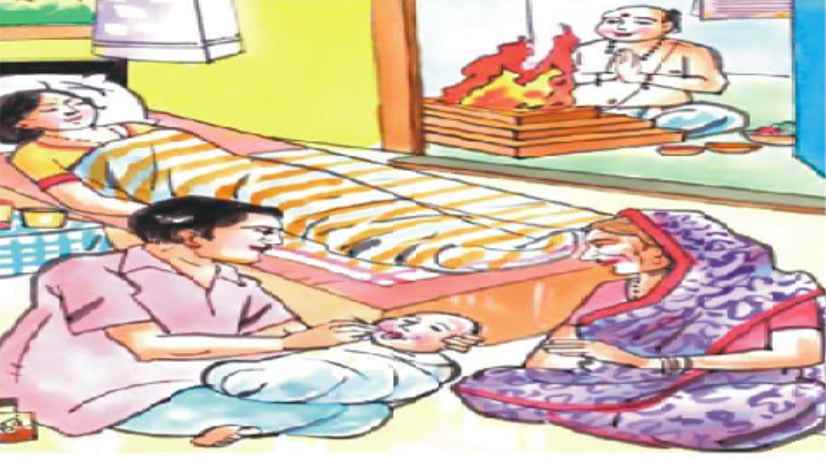
When a kid is born, a ritual known as Jaat-Karm Sansakar is conducted, because the newborn begins to connect with the tangible world when he or she is born. This rite removes a wide range of problems and flaws. The newborn is fed honey and ghee at this ceremony, and Vedic chants are chanted in order for the child to live a long and healthy life.
Bathing, cleaning the mouth, feeding honey and ghee, breastfeeding, leaking, and other important rites are performed in front of the godhead while chanting Vedic mantras and shlokas.
One of the divine ceremonies is offering two drops of ghee and six drops of honey in the sacred hawan with unique mantras during Jaatakarm sanskaar.
Following the particular recitation of the nine mantras, everyone prays for the child’s intelligence, strength, health, and longevity while offering petitions to divinity.
For the last ceremony, the mother breastfeeds the kid.
5. Naamakaran
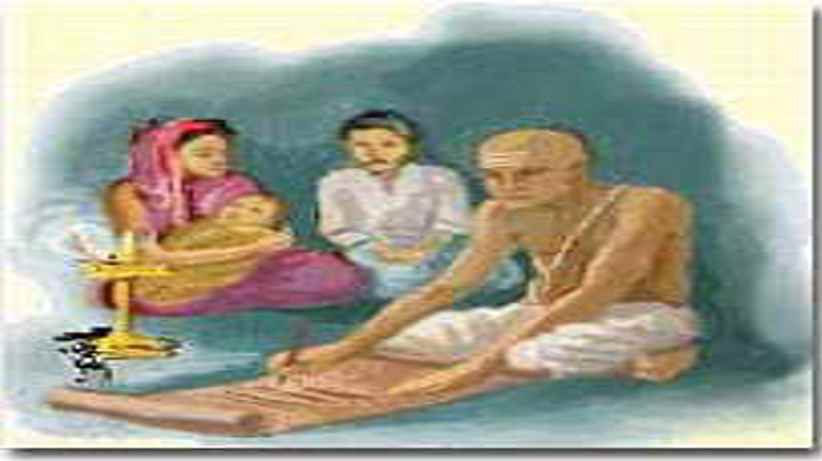
The naming ceremony is the fifth rite in Hindu religious rituals. This sanskar should be performed on the eleventh day after the birth of the child. The reason for this is that according to the Parashara Smriti, a Brahmin in the Sutak of birth is purified in ten days.
Regarding the naming ceremony, it is written in the Smiriti Pura –
आयुर्वेडभिवृद्धिश्च सिद्धिर्व्यवहतेस्तथा ।
नामकर्मफलं त्वेतत् समुद्दिष्टं मनीषिभिः ।।
(अर्थात् नामकरण-संस्कार से आयु तथा तेज़ की वृद्धि होती है एवं लौकिक व्यवहार में नाम की प्रसिद्धि से व्यक्ति का अलग अस्तित्तव बनता है।)
In this sacrament, the infant is given a sweetly sweet speech after licking honey, the sun is presented and it is hoped that the child will drink the sun’s brightness, and by bowing down to the land, devotion to God’s culture is provided. Everyone desires the kid, now that he has a new name, to be Chiranjeevi, devout, healthy, and prosperous.
All of this happens according to a set routine, including what time the infant was born, in which constellation, zodiac, and so on. The house priest or pandit names the child based on the infant’s birth-nakshatra, planet, zodiac, and other factors. The naming of four brothers, such as Shri Ram, is stated in the Valmiki-Ramayana, and Maharishi Garg is credited with naming Shri Krishna based on his traits and religions.
6. Nishkarnam
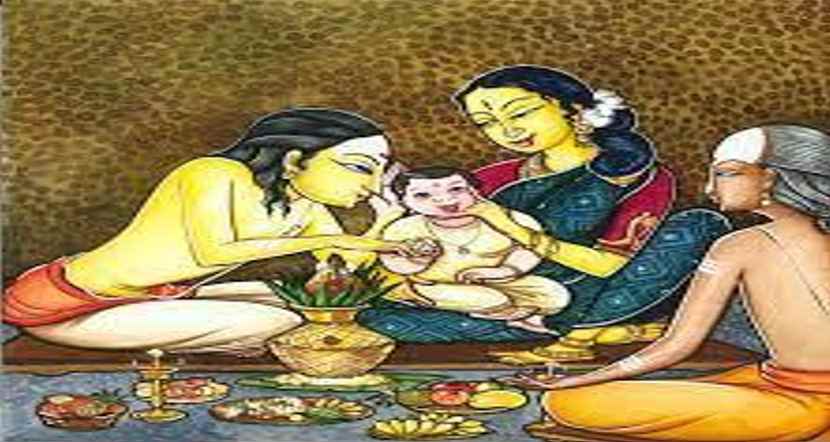
- Nishkraman is a word that means “to leave.” This ceremony is carried out in the fourth month following the birth of the child. Earth, water, fire, air, and sky make up our body, which is known as Pancha-Bhoota. As a result, Father prays to these five gods for the child’s well-being. Also, hope that his child lives a long and healthy life.
शिवे ते स्तां द्यावापृथिवी असंतापे अभिश्रियौ। शं ते सूर्य
आ तपतुशं वातो ते हदे। शिवा अभि क्षरन्तु त्वापो दिव्यः पयस्वतीः ।।
(अर्थात हे बालक! तेरे निष्क्रमण के समय द्युलोक तथा पृथिवीलोक कल्याणकारी सुखद एवं शोभास्पद हों। सूर्य तेरे लिए कल्याणकारी प्रकाश करे। तेरे हदय में स्वच्छ कल्याणकारी वायु का संचरण हो। दिव्य जल वाली गंगा-यमुना नदियाँ तेरे लिए निर्मल स्वादिष्ट जल का वहन करें।)
- The fruit of this ritual has been told by scholars to increase the health and age of the child.
निष्क्रमणादायुषो वृद्धिरप्युद्दिष्टा मनीषिभिःl
7. Annaprashan
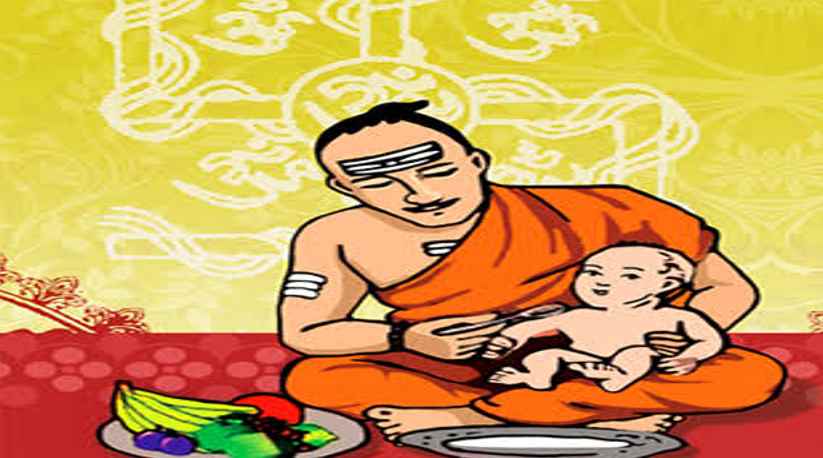
‘Annaprashan’ is a Sanskrit word that means ‘beginning to consume grain’.
This rite is conducted when a child’s first tooth appears, around the age of 6-7 months. On this day, the mother places the first morsel of food in the mouth of a baby by placing it in a silver dish.
The first mantra in Yarujudeva’s 40th chapter, says;
तेन त्यक्तेन भुंजीथा
(Have food with renunciation.)
- Special rituals are performed after completing the sequence from invocation to protection in the prescribed order. in that
- Patra Pujan
- Anna Sanskar
- Special sacrifice (Vishesh Aahuti)
- Kheer Prashan
ॐ हिरण्मयेन पात्रेण सत्यस्यापिहितं मुखम्। तत्त्वं पूषन्नपावृणु सत्यधर्माय दृष्टये॥
Parents should recite this mantra and build a Swastika out of Chandan and Roli outside the sacred vessel-bowl that will be used for Annaprashan, as well as offering flowers and rice. Consider how divinity is being established in the sacred bowl under the power of the holy atmosphere, which will safeguard the child’s nourishment.
For the child’s longevity, parents should take some rice and vermillion in their hands and chant the mantra with the Brahmin.
Parents should take the bowl of kheer and recite the mantra for the next ritual
Then mix all the things properly one by one while reciting mantras.
- Then they should concentrate on the gods, imagining that this food is going to shower blessings, happiness, and wealth onto the child. Proffer a little bit of Kheer with a spoon to the child while chanting mantra.
ॐ अन्नपतेन्नस्य नो देह्यनमीवस्य शुष्मिणः। प्रप्रदातारं तारिषऽऊर्जं नो धेहि द्विपदे चतुष्पदे॥
8. Mundan

The hair on the baby’s head is plucked for the first time during this rite. Mundan should be performed till the child is one year old or until the child has completed two years in the third year, according to the worldly norm. This function is critical because, at this time, extra attention is paid to brain growth and protection, and a program is included in child up-ringing to ensure that mental development begins in a systematic manner.
Since the time of delivery, In Hinduism, it is required to clean the infant’s skull by eliminating the germs that were born over the child’s head during birth, a procedure known as Choora Karma Sanskar. This Brahmin ceremonial rite is well-known and well-liked all throughout the world. From a delicate perspective, awareness is required for a child’s systematic intellectual development, the eradication of negative thoughts, and the creation of noble concepts.
तेन ते आयुषे वपामि सुश्लोकाय स्वस्त्ये।
(अर्थात चूडाकर्म से दीर्घ आयु प्राप्त होती है। शिशु सुंदर तथा कल्याणकारी कार्यों की और प्रवृत्त होने वाला बनता है।)
The macro-subtle aims were kept together to determine the essence of this sanskar.
This sanskar is performed at a sacred religious pilgrimage location at an auspicious time. The Satyanarayan puja can be performed at home to perform the rituals. It is thought that the divine atmosphere of the religious venue aids the ritualistic procedures performed for the kid.
In the Vedas, the description of Chudakarma-sanskar is found in detail. It is written in Yajurveda –
नि वर्त्तयाम्यायुषेड्न्नाद्याय प्रजननाय।
रायस्पोषाय सुप्रजास्त्वाय सुवीर्याय।।
( अर्थात हे बालक! मैं तेरी दीर्घायु के लिए, तुझे अन्न-ग्रहण करने में समर्थ बनाने के लिए, उत्पादन शाक्ति प्राप्ति के लिए, ऐश्वर्य वृद्धि के लिए, सुंदर संतान के लिए एवं बल तथा पराक्रम प्राप्ति के योग्य होने के लिए तेरा चूडाकर्म संस्कार (मूडंन) करता हूं।)
9. Vidyaarambha
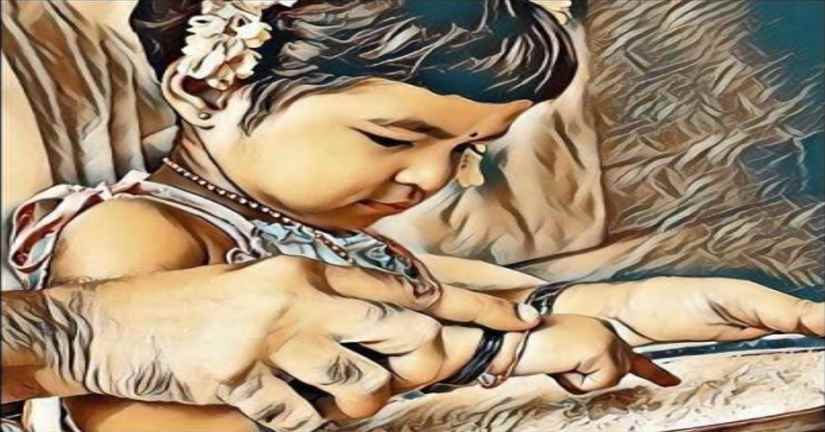
Vidyarambh is performed when a boy or girl reaches the age where he or she is eligible for education.
From this day forward, the child will attend school.
Parents and instructors are made aware of their sacred and tremendous obligation to educate the kid with alphabets, topic knowledge, and to assist them to grasp the methods and sources for leading a better life through the ritual, which on the one hand instills a love of learning in the child.
In this rite, images and statues of Lord Ganesha and Goddess Saraswati are worshipped alongside pencils, notebooks, slates, chalk, and other useful items. Teachers are also revered, and if the teachers are not there, the coconut might be worshipped in their place as a symbol.
According to Muhurat Shastra, the work starts inauspicious time gives favorable and prosperous results, and the best date for Vidyaarambha is in the Magh Shukla during the Panchami Tithi.
The mother and teacher teach the child to write Ohm (aum) as his or her first word because it is thought that aum (ohm) was the first word to be presented to the world.
10. Karnaveda
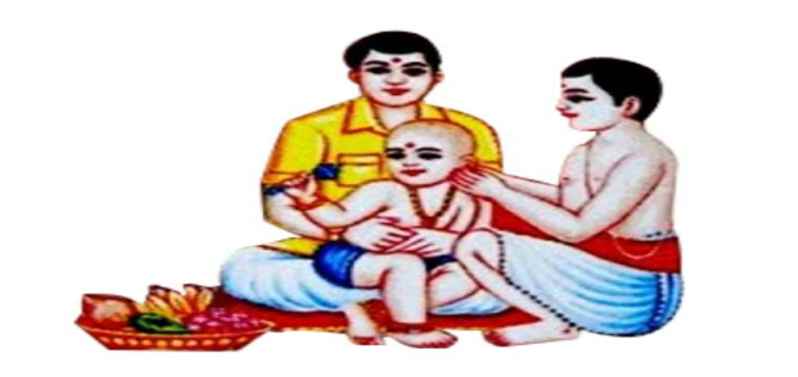
In this ceremony, the earlobes are pierced. There are two reasons for this, the first of which is to wear jewelry. Acupuncture is the second reason, which involves piercing the ear. The blood flow in the veins leading to the brain is improved as a result. It improves hearing and protects against a variety of ailments. On this day, pray for the intellectual development of the child after worshipping and performing this Karnavedha Sanskar ceremony.
First of all the deities are worshiped, then facing the sun, the ears are pierced with gold, silver or iron needles after reciting the mantra in the ear of the child.
भद्रं कर्णेभिः क्षृणुयाम देवा भद्रं पश्येमाक्षभिर्यजत्राः।
स्थिरैरंगैस्तुष्टुवां सस्तनूभिर्व्यशेमहि देवहितं यदायुः।।
(तात्पर्य है कि हमारे शरीर के सभी अंग और इंद्रियां स्वस्थ एवं क्रियाशील बने रहें और हम सौ या उससे अधिक लंबी आयु पावें ।)
- If it is a boy, then the right ear is pierced first and if it is a girl, then the left ear is pierced first. It is believed that during this time it is more appropriate to wear a gold coil or jewelry, as it makes both the parts of the brain very strong due to the effect of electricity.
11. Upnayana
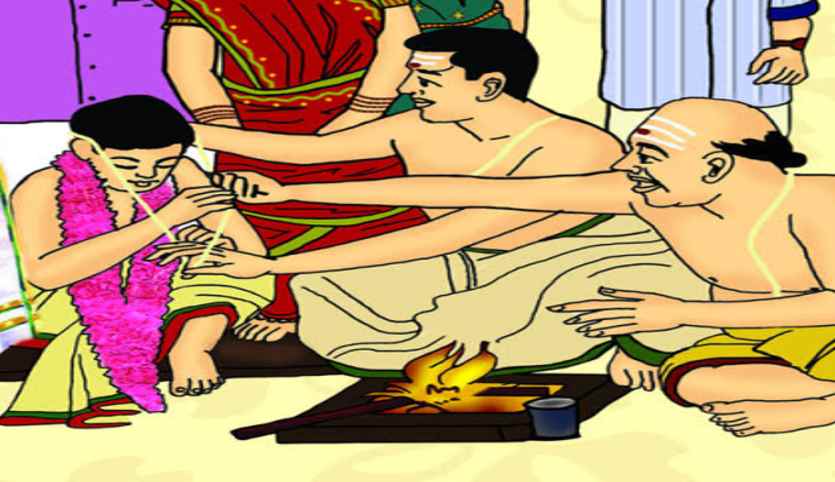
Up indicates close Nayan means to take away. The Upanayan sanskar refers to being taken close to the Guru (teacher). This custom is still followed today. The three gods-trinities-Brahma, Vishnu, and Mahesh are the symbols of Janaeu, which means Yagyopavit in Sanskrit. This sanskar is also known as Yagyopavit sanskar. This sacrament provides power, vigour, and strength to the kid.
This sanskar is conducted when a Brahmin child reaches the age of eight. The child is initiated into the Gayatri Mantra and made to wear Yagyopaveet during this rite. The Vedas, in particular, are studied according to their several branches. The right to undertake this ceremony has not been granted to girls.
- Only marriage-sanskar is seen as a rite of passage in the form of dualism for them.
12. Vedarambha
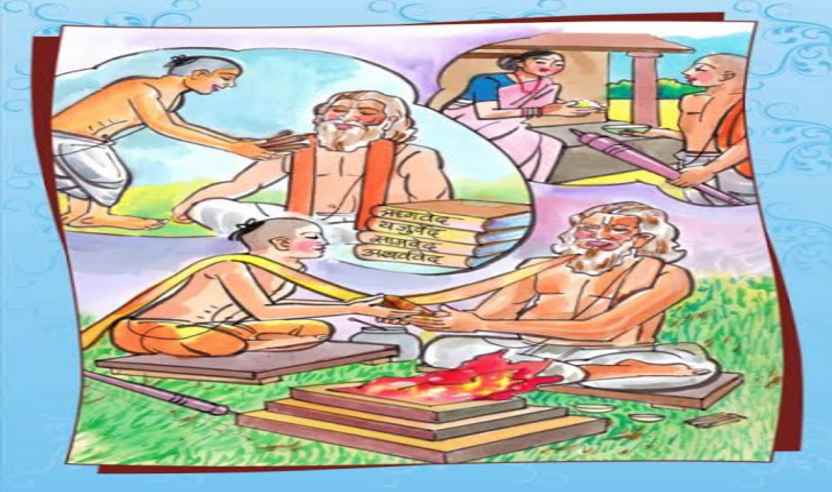
- The person receiving this sanskar is given knowledge of the Vedas. Many academics compare the Akshargyan sanskar to Vedaramba Sanskar.
विद्यया लुप्यते पापं विद्यायाऽयुः प्रवर्धते।विद्याया सर्वसिद्धिः स्याद्विद्ययाऽमृतमश्रुते।।
(अर्थात वेद विद्या के अध्ययन से सारे पापों का लोप होता है, आयु की वृद्धि होती है, समस्त सिद्धियां प्राप्त होती हैं, यहां तक कि उसके समक्ष अमृत-रस अक्षनपान के रूप में उपलब्ध हो जाता है। )
According to them, neither the Vedas nor the written scriptures can be studied without first learning the letters. As a result, they place a greater emphasis on Akshargyan sanskar before Vedaramba Sanskar. Many experts believe that the person had no prior understanding of the script or letters. As a result, only Gurmukh (guru’s speech) studied the Vedas.
Prior to the Vedarbham, Acharya encouraged his disciples to observe the Brahmacharya fast and commit to living a simple life; nevertheless, they were only allowed to study after passing the test. All of our Vedas are complete knowledge reservoirs.
13. Keshant
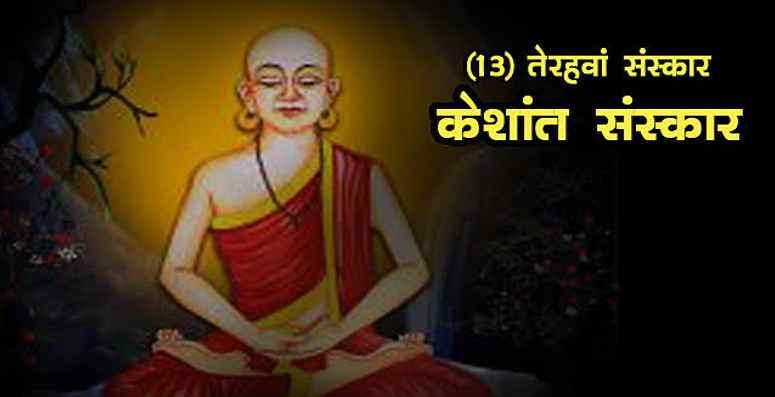
Haircutting with proper rites and ceremonies is known as Keshant Sanskar. Keshant Sanskar was performed after receiving education from a Gurukul in ancient times. Although the names Keshant sanskar and Mundan sanskar appear to be the same, there is a distinction.
Mundan Sankar is performed during childbirth, whereas Keshant Sankar is conducted after the child reaches puberty when the boy develops a mustache and beard on his face. His beard and mustache, as well as his hair, are all shaved during this ceremony.
14. Samavartan
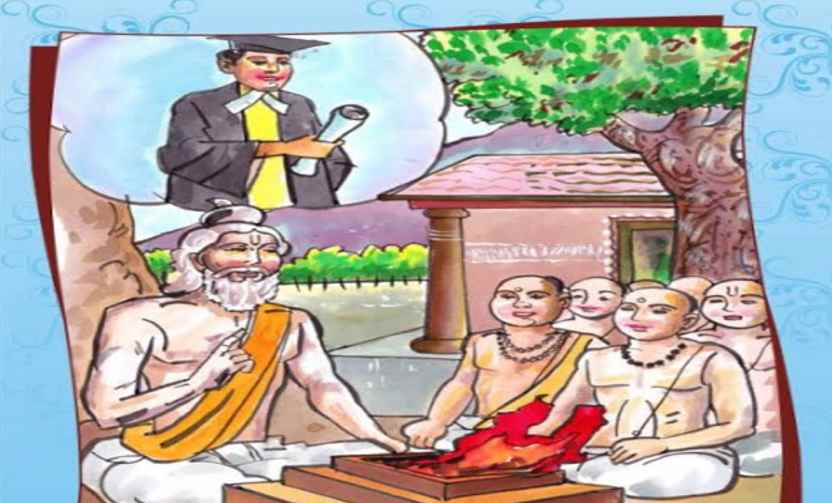
- Samavartan Sanskar literally means “to return.” This rite was performed when a person completed their education at an Ashram or Gurukul in order to reintegrate them into society. When a person is bid farewell to the Gurukul after completing his education, he is given a farewell by the Guru preaching for the coming life in ancient times. Prior to conducting Keshant sanskar, Brahmchari bathed. This bath is part of the ceremony. There is a commandment that says you must bathe with eight pitchers of water packed with aromatic compounds and medicines at the north part of the altar. There was special chanting accompanying this bath. After that, the brahmachari would give up the mekhla he had received at Yagyopaveet. Acharya used to confer the title of ‘Bachelor of Education’ on him after this event. He was proudly allowed to enter the homestead because of this title. Adorning one with gorgeous garments and ornaments.
युवा सुवासाः परिवीत आगात् स उ श्रेयान् भवति जायमानः।
तं धीरासः कवय उन्नयन्ति स्वाध्यों 3 मनसा देवयन्तः।।
(अर्थात् युवा पुरुष उत्तम वस्त्रों को धारण किए हुए, उपवीत (ब्रह्मचारी) सब विद्या से प्रकाशित जब गृहाश्रम में आता है, तब वह प्रसिद्ध होकर श्रेय मंगलकारी शोभायुक्त होता है। उसको धीर, बुद्धिमान, विद्धान, अच्छे ध्यानयुक्त मन से विद्या के प्रकाश की कामना करते हुए, ऊंचे पद पर बैठाते हैं।)
15. Vivah
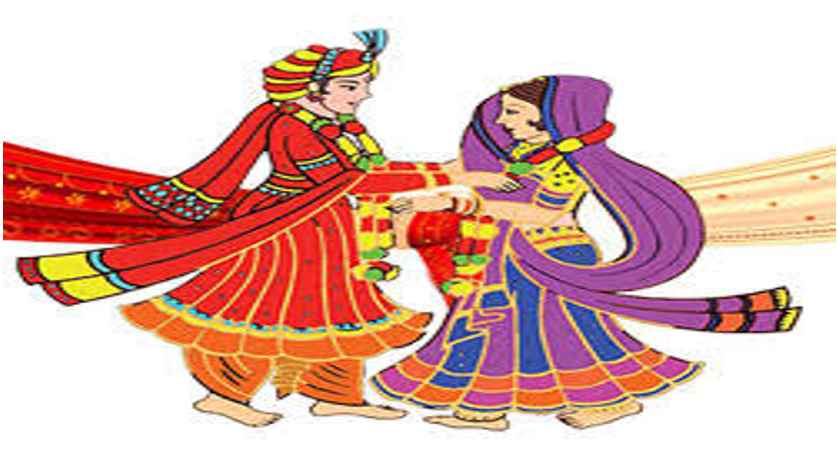
The most important ceremony is the Vivah Sanskar (marriage rites). The bride and groom sign a contract agreeing to stay together and practice ethics. Human beings are born with three debts: the ‘Dev debt,’ the ‘Rishi debt,’ and the ‘Pitra debt.’ This sanskar is done to pay off a debt owed to one’s ancestors.
Vivah means ‘To bear responsibility in a special way’.
In Hindu culture, marriage is the most sacred religious sacrament, (Yagya). In marriage, two beings (bride and groom) end their separate existences, form a cohesive unit, and move on the path of progress like two wheels in a cart, benefiting each other from their abilities and feelings.
Hindu marriage is a relationship between husband and wife that is never-ending under any circumstances. By taking seven rounds of fire (saat free) and considering the pole star as a witness, two bodies, mind and soul are bound in a sacred bond. In Hindu marriage, there is a more spiritual relationship between husband and wife than a physical relationship, and this relationship is considered very sacred.
16. Antyesthi

Antyesthi sanskar means funeral ceremony. Antyeshti means ‘Antim yagya’. In other words, it is the final process of the sacrifice of life. Ideally, the rites begin from the moment of conception and are performed at each important stage in a person’s life. As death approaches, relatives and priests are called, ministers and sacred texts are recited, and ceremonial offerings are prepared. After death, the dead body is taken to the cremation ground, which is usually located on the river bank. The eldest son of the deceased and the ceremonial priest perform the cremation.
In Baudhayana Pitrumedhasutra-
जातसंस्कारैणेमं लोकमभिजयति मृतसंस्कारैणामुं लोकम्।
(जातकर्म आदि संस्कारों से मनुष्य इस लोक को जीतता है; मृत-संस्कार, “अंत्येष्टि” से परलोक को)
- Following this, members are regarded impure in Brahmins for ten days and are subject to certain taboos. They execute rituals during this time in order for the soul to enter the next life. Offerings of milk and water, as well as bodies of uncooked rice, are used in these rituals. On a specific date, the bone remains taken from the cremation ground is either buried or tossed into the river. Shradhs are rituals conducted by family in honor of the deceased on specific occasions.
Famous Brahmin Personalities
1. Chandra Shekhar Azad
- Chandra Sekhar Azad was a freedom fighter and an Indian revolutionary who reorganized the Hindustan Republican Association.
2. A. Krishnaswami Ayyangar
- An Indian Mathematician wrote an article on the difference between the Chakravala method and Continued Fractions.
3. Dhondo Keshav Karve
- He was a social reformer who built India’s first school for widows and the first university for women. He also received Bharat Ratna.
4. Krishnaswamy Sundarji
- He was the 13th Chief of Army Staff of the Indian Army (1986 – 1988) and the last former British Indian Army officer to command the Indian Army. He received Param Vishisht Seva Medal.
5. V. Raman
- He was an Indian physicist known for his work in the field of light scattering. He was awarded Nobel Prize in 1930.
6. Maharshi Dayanand Saraswati
- He was an Indian philosopher, social leader, and founder of the Arya Samaj, a reform movement of the Vedic dharma.
7. Tirumalai Krishnamacharya
- He was an Indian yoga teacher, ayurvedic healer, and scholar. He is considered as “Father of Modern Yoga”.
8. Sir Benegal Narsing Rau
- An Indian Judge of International Court of Justice. He played a key role in drafting the Constitution of India. He was also the President of the UN Security Council and Prime minister of Jammu & Kashmir.
9. Rukmini Devi
- She was an Indian Classical Dancer who catalyzed the renaissance of Bharatanatyam dance. She was the first woman in India to be nominated as a member of the Rajya Sabha. She received Padma Bhushan.
10. Goswami Tulsidas
- He was a Ramanandi Vaishnava Hindu saint and poet, renowned for his devotion to the deity Rama. He was the author of the epic poem Ramcharitmanas.
Brahmin Communities Outside India
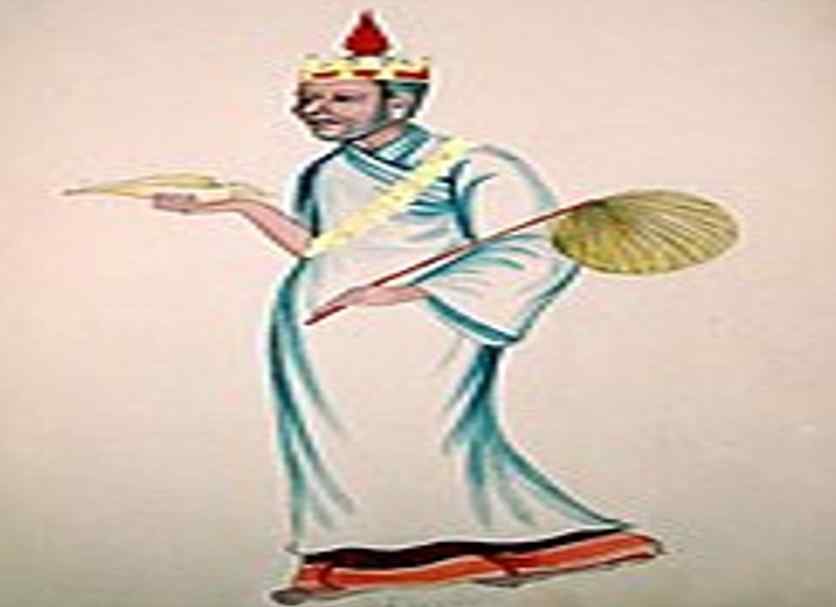
- Anthony Reid states, that Hindu Dharmasastras particularly Manusmruti, were honored in Burma (Myanmar), Siam (Thailand), Cambodia, and Java-Bali (Indonesia) as the defining documents of law and order, which kings were obliged to uphold. In Burma and Siam, these were copied, translated, and incorporated into local law codes with tight respect to the original wording. In Java (Indonesia), there was a larger desire to adapt to local demands.”

In southeast Asia in the 1st millennium CE, a Brahmin prince named Kaundinya married a Naga princess living in the flooded lands and founded Kambuja-Desh (Cambodia). Late he introduced Hinduism, particularly Bramha, Vishnu, Mahesh, and Harihar (half Vishnu, half Shiva).
From the recorded history it is also clear that Brahmin had spread in Thailand too.
The king of Thailand, Rama l established the Brahmanical temple Devasathana in 1784 by hosting Phra Phikhanesuan (Ganesha), Phra Narai (Narayana, Vishnu), Phra Itsuan (Shiva), Uma, Brahma, Indra (Sakka), and other Hindu deities. which has been managed by the ethnical Thai Brahmins ever since. These roots assert that Brahmins have been part of the royal tradition of Thailand.
Current Population Of Brahmins

The population of India that is considered a member of the Brahmin caste according to the article is about 60,481,000 people. That’s approximately 4.3 percent of the total Indian population.
The majority of Brahmins live in the northern Indian states of Uttar Pradesh and Andhra Pradesh, with modest populations in the southern states of Tamil Nadu, Karnataka, and Kerala.
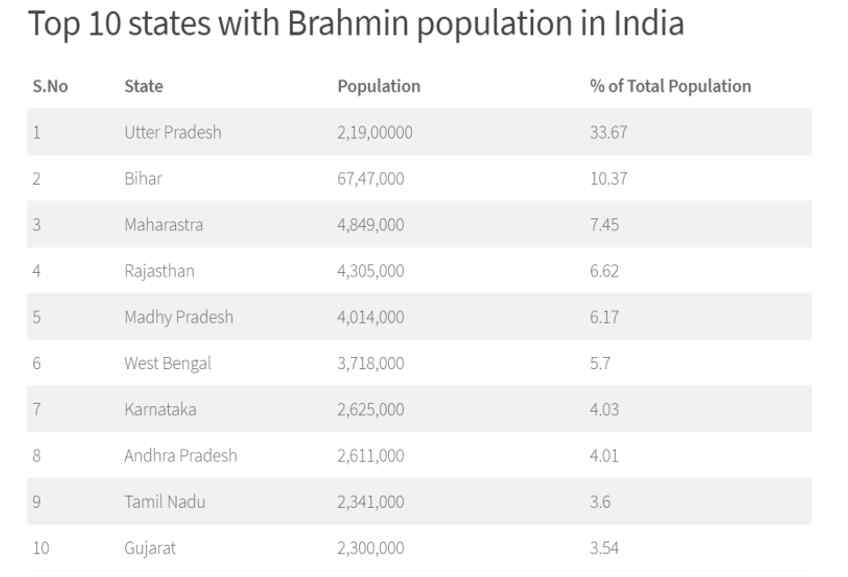
Brahmins were separated into two groups as a result of this territorial division: the Panch Gour (northerners) and the Panch Dravida (southerners) (Southerners). The central Indian Vindhya mountain range, which virtually divides the country in two, separates these two groups.
As per the census 2014, the total Brahmin population in India is around 5% and which is around 6.5 crores.
Controversies
From the report of July 21, 2021, Suresh Raina, a former India cricketer, has sparked a stir with his remark during the Tamil Nadu Premier League commentary that “I am Brahmin.” Raina associated his Brahmin identity with Chennai’s culture.
Kannada film actor Chetan had tweeted, “Brahminism is the negation of the spirit of Liberty, Equality, Fraternity. We must uproot Brahminism- #Ambedkar. ‘While all are born as equals, to say that Brahmins alone are highest and all others are low as untouchables is sheer nonsense. It is a big hoax’ – #Periyar”.
This statement of his has snowballed into controversies, which landed him with a police complaint and Minister Shivaram Hebbar demanding his arrest. (12 June 2021) Once again Brahmins were involved in a controversy regarding atrocities against Dalit in Bengaluru and ruler districts in 2017. Where people started to oppose Brahmanism by using the words of B. R. Ambedkar, who argued that without a robust movement against Brahmanism, Dalit emancipation is impossible. They believed that the prime mover behind such atrocities against Dalit was Brahmanism.
From the report of Dec 19, 2021, former Bihar Chief Minister Jitan Ram Manjhi sparked a new controversy with his anti-Brahmin statements. Manjhi’s statement made it apparent that he was not only attacking Brahmins but also expressing his disgust with Dalits joining mainstream Hinduism. Manjhi also questioned the existence of Lord Ram in his discourse.
Top 13 Amazing Facts About Brahmin
Brahmin is a Varna originated by Bramha through his mouth.
A TRUE Brahmin is one who has attained brahminhood through his good deeds rather than by birth.
According to the Brihadaranyakopanishad, males were either Brahmins or Sudras in the beginning.
Brahman, the ultimate reality, has both qualities and none. Sagun Brahman is a Brahman with qualities, while Nirgun Brahman is a Brahman without attributes.
Bramha created four clans (Varana) according to Vedas and spiritual books, but these clans have evolved into castes over time.
According to Dharmacharan, Brahmins have 6 duties: Bathing, Sandhyavandanam, Japa, Upasana, and Agnihotra. The last two yagyas are now performed only in a few families.
Brahmins used to be exclusive to the priesthood, but they have expanded into practically every field over time.
Only 5-6 sanskars are performed nowadays out of a brahmin’s 16 sacraments.
Not only in India, but also in Myanmar, Thailand, Cambodia, Vietnam, and Indonesia, Brahmins have developed over time.
Brahmins are noted for being exceptional athletes, wrestlers, and strength athletes. They have a good reputation for bravery as well.
A huge number of Brahmans have evolved over time which belongs to the first type of Brahmans (Smriti Puran), which is referred to as ‘Mere’.
Brahmins have evolved much in the northern part of India.
Brahmin issues continue to erupt as a result of popular misconceptions about them. Dr. B. R. Ambedkar attempted to define Brahmanism’s genuine meaning.




